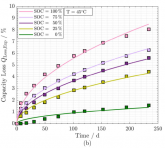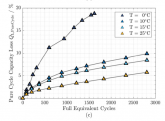If the cells aren't yet balanced (and the obviously aren't if we are now balancing them), one cell may hang at 3.38v while another zooms up quickly to 3.5v. That higher cell may stay in the upper knee for hours waiting for the lower cell to catch up. Equalizing them at 3.4v first insures this doesn't happen. That's the way I read between the lines?
This is physically impossible when all cells are connected in parallel, which is a premise for this procedure.
As cells become fuller and fuller, their individual SOC gets equalized naturally because current splits naturally between cells based on their demand, which is controlled naturally by change in IR as the cell gets charged.
The idea not to leave cells above the knee for "too long" is a sound idea in principle and has merit, but what people get hung up on due to their ignorance is how to quantify "too long". The effect of "too long" is measured in weeks/months, not hours or minutes.
There is absolutely no harm in staying above the knee for many hours, just don't do it for weeks or months.
The rest of my post is a general rant, not pointing to
@SolarRat or anyone in particular, not even
@ghostwriter66 who's info is generally true and helpful, but not very well understood, no offense...
Making something sound like a Bible because it came from some "Design Engineer at largest LFP factory", please. If you can't post the name of the factory and educational background of this "Design Engineer" which can be independently verified, then it's no different than any other piece of FUD on the Internet.
I am a Design Engineer at one of the largest LFP battery makers in the US, with UL1973 certifications and many 1000s of systems deployed all over the world for over 10 years now. Does it make my statement credible unless I post the name of the company and my name, so it can be verified? Absolutely not. As far as this forum is concerned, I'm just an anonymous dude sitting at my keyboard making stuff up.
My point is, please don't believe anything unless you can verify it with credible sources.
There is way way too much FUD around Lithium batteries. At least 50% of info on this forum and most others is complete nonsense based on ignorant repeating of unverified and misunderstood sources.






